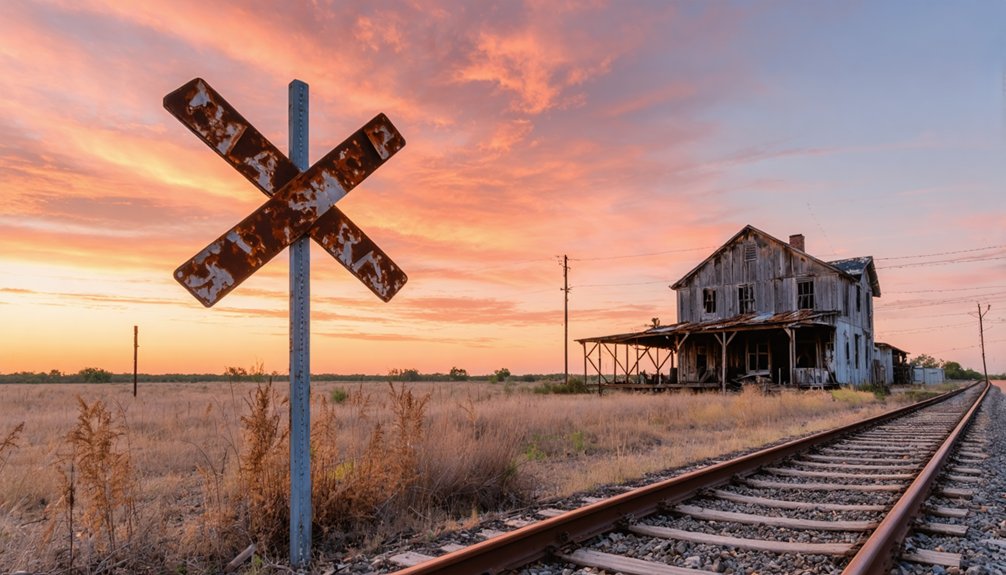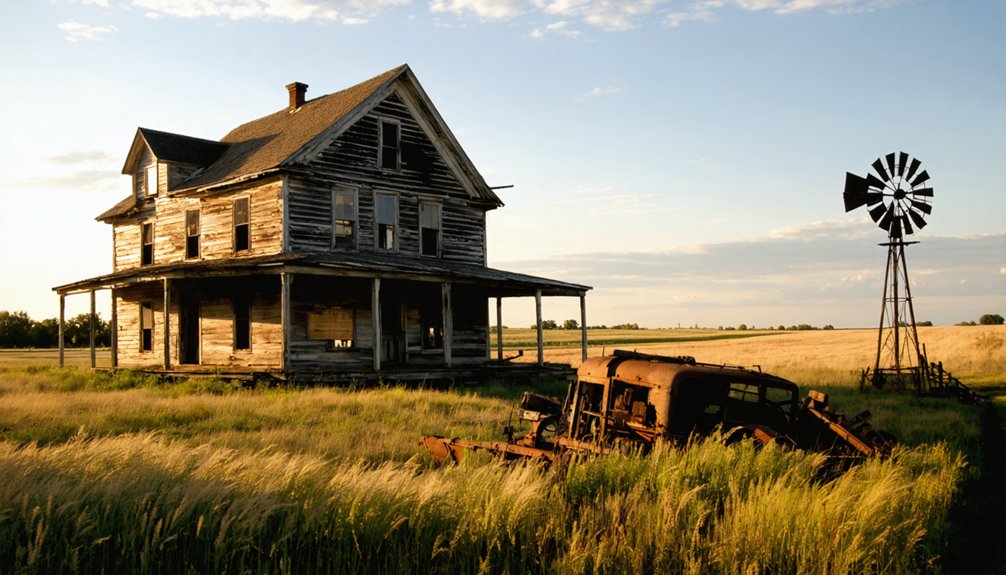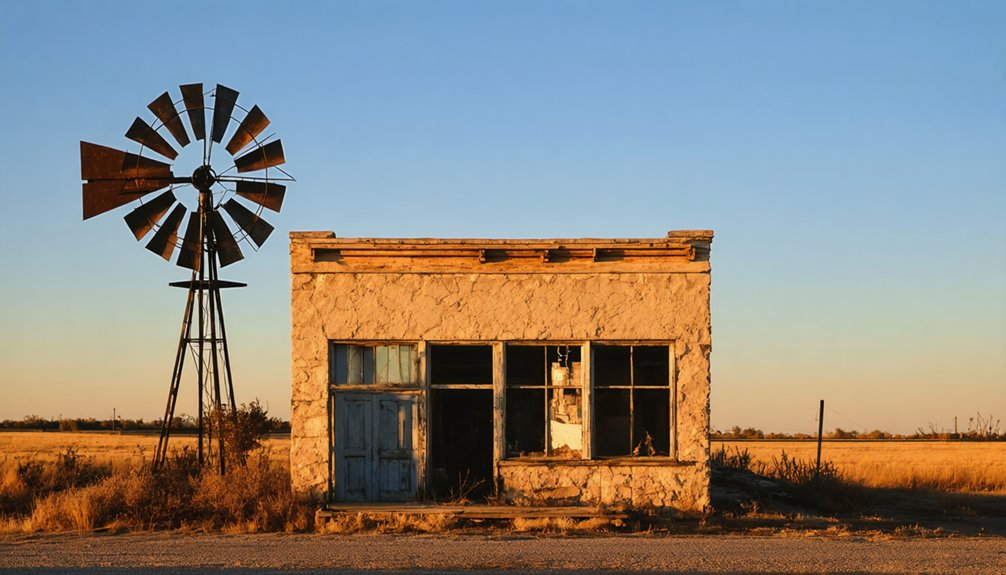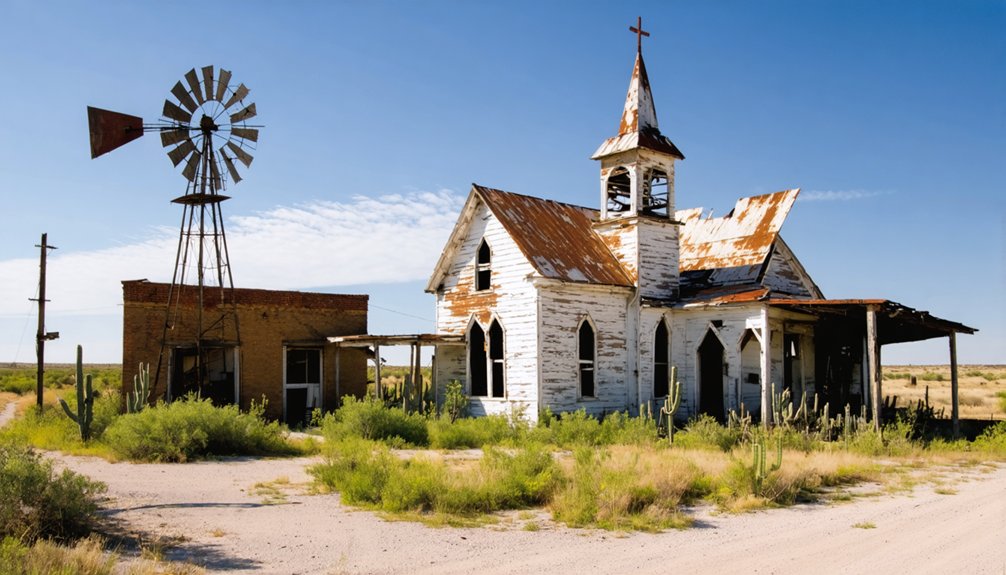You’ll find Manda, a former Swedish settlement established in 1885, in northeastern Travis County, Texas. Named after Amanda Bengtson Gustafson, this once-thriving farming community centered around a steam cotton gin and two-room schoolhouse. The town’s isolation from major transportation routes led to its decline, as residents relocated to rail-connected areas. Today, you can explore the renovated schoolhouse and historic cemeteries that showcase Manda’s rich Scandinavian heritage. The story behind this ghost town reveals fascinating details of Texas immigrant life.
Key Takeaways
- Manda, Texas was established by Swedish immigrants in 1885 and named after Amanda Bengtson Gustafson, sister of the local postmaster.
- Limited transportation routes and isolation from railways led to Manda’s economic decline as residents moved to better-connected towns.
- The community’s decline accelerated with agricultural mechanization and young residents leaving for urban areas with better employment opportunities.
- Closure of key institutions like the Methodist church and local schools in 1947 marked the end of Manda’s vibrant community life.
- Today, Manda exists primarily through its renovated schoolhouse-turned-community center and historic cemeteries reflecting its Swedish heritage.
The Pioneer Settlement Years (1885-1888)
As Swedish immigrants sought new opportunities in Texas during the late 19th century, they established the rural settlement of Manda in northeastern Travis County around 1885.
Named after Amanda Bengtson Gustafson, sister of the local postmaster, the community reflected the strong cultural traditions of its Scandinavian founders. The name held special significance, as it derived from the Latin term meaning worthy of love.
The legacy of Swedish heritage lived on through Manda’s namesake and the cultural bonds of its immigrant founders.
You’ll find that settlement patterns centered around essential structures – a wooden schoolhouse, family farms, and basic road connections to neighboring communities like New Sweden.
The pioneer families maintained their agrarian lifestyle, sharing labor during planting and harvest while building a close-knit society through family ties and community gatherings.
Though isolated from major transportation routes, they established postal services and developed sufficient infrastructure to support their farming community’s daily needs and social functions. Today, the old schoolhouse remains as one of the few surviving structures from this once-thriving settlement.
Swedish Heritage and Early Settlers
While Swedish immigrants had been arriving in Texas since 1848, Manda’s founding in the 1880s emerged from a larger wave of Scandinavian settlement influenced by pioneers like Swante M. Swenson.
You’ll find immigrant stories woven throughout Manda’s early development, from the Palm family’s leadership in helping newcomers establish roots to Amanda Bengtson Gustafson, whose first name became the town’s namesake. The population of Swedish Texans grew substantially during this period, reaching 4,344 Swedish residents by 1900.
Swedish traditions flourished as settlers built both Lutheran and Methodist congregations, with the Methodist church constructed in 1909 serving the community until 1962. The Manda School District formed in 1947 when local schools consolidated to better serve the area’s educational needs.
The town quickly grew to include essential services like a cotton gin, general store, and blacksmith shop.
Many early settlers maintained connections to Barkeryd parish in Småland, creating a tight-knit community that preserved their cultural heritage while building a new Texas home.
Life in Early Manda
Life in early Manda centered on the daily rhythms of farming the rich Blackland Prairie soil, where you’d find families working from sunrise to sunset tending to crops and livestock.
You’d witness the steam cotton gin, operated by J. Victor Morell, bustling with activity during harvest seasons as farmers brought in their cotton yields.
The pioneer families faced typical rural challenges of the era, relying heavily on each other for labor and support while maintaining close ties through their shared Methodist and Lutheran faith communities. The Swedish immigration wave brought the first settlers who established this close-knit farming community in the late 1880s.
The community’s dedication to education was evident through the Manda School District, which served local children and remained a vital part of daily life until 1947.
Pioneer Living Conditions
During Manda’s early settlement period, pioneers faced stark living conditions that demanded resilience and resourcefulness. Like early settlers faced isolation in their scattered homesteads, residents had to be highly self-sufficient.
You’d find yourself living in a modest wooden cabin, often built with your own hands using local timber. Like early settlers managing 75,000 head of cattle in Gonzales County by 1870, residents had to be highly organized and resourceful to survive. Inside, you’d rely on wood-burning stoves for warmth and cooking, while simple handmade furniture met basic needs.
Pioneer hardships included hauling water from wells or creeks, using outdoor privies for sanitation, and preserving food through smoking and salting.
You’d make most of your clothing at home, repeatedly mending garments to extend their life. Communal living proved crucial for survival, with neighbors helping each other during challenging times.
The Swedish Methodist church and Lutheran chapel became essential social hubs where you’d gather for support, while local schoolhouses served as community centers after hours.
Daily Farming Activities
As dawn broke over the Blackland Prairie, you’d begin your daily farm routine by tending to livestock and preparing for fieldwork. Your success depended on carefully managing both crops and animals across the seasons, implementing crop rotation to maintain soil fertility and prevent pest problems.
Your typical day would follow this essential rhythm:
- Early morning: Feed and water livestock, milk cows, gather eggs from the chicken coop
- Mid-morning to afternoon: Work the fields with horse-drawn plows, plant or harvest depending on season
- Late afternoon: Repair fences, maintain tools, tend to equipment
- Evening: Preserve food, plan next day’s work, handle livestock management duties
You’d often share resources with neighbors during busy seasons, creating strong community bonds through cooperative farming practices. Like many of the 511 ghost towns across Texas, these daily routines gradually faded as communities declined and families moved away. Many families eventually relocated to larger communities like Bartonsite structures, which were moved wholesale to nearby towns as populations dwindled.
The Old Schoolhouse Legacy
Standing as a tribute to Swedish immigrant ambition, the Manda School opened its doors in 1916 as a two-room schoolhouse serving the local farming community.
The old schoolhouse’s significance extends beyond its humble architecture, as it became the heart of education and cultural preservation for this tight-knit settlement.
You’ll find the building’s educational legacy deeply rooted in the community’s agricultural rhythm. Until 1947, it served as both a learning center and gathering space where farming families maintained their cultural bonds.
After the district’s consolidation, you can still witness how the structure adapted to changing times – transforming into a community center while preserving its historical identity.
The Texas Historical Commission recognized this enduring heritage with a marker in 1990, cementing the schoolhouse’s place in Manda’s story.
Transportation’s Role in Manda’s Fate

While railroad expansion transformed countless Texas towns in the late 1800s, Manda’s isolation from major rail routes sealed its fate as a ghost town.
You’ll find that transportation infrastructure played a critical role in determining which settlements thrived and which faded into history.
The impact of Manda’s disconnection from essential transport networks resulted in:
Isolation from vital transportation routes doomed Manda to decline, cutting off access to commerce, people, and progress.
- Widespread population shifts as residents relocated to rail-connected towns
- Severe economic decline due to limited access to markets and trade
- Loss of commercial activity and crucial services
- Inability to compete with better-connected neighboring settlements
Even modern road development bypassed Manda, leaving it stranded on Austin’s outskirts.
Without access to major transportation arteries, the town couldn’t sustain itself, making its transformation into a ghost town virtually inevitable.
Agricultural Roots and Rural Character
You’ll find Manda’s earliest foundations in its Swedish immigrant farming families who settled the fertile Blackland Prairie of northeastern Travis County in the 1880s.
These pioneering settlers established productive farmsteads, working the rich prairie soil with traditional European farming methods they’d adapted to Texas conditions.
Their agricultural focus shaped every aspect of early community life, from the establishment of the Methodist and Lutheran churches to the rhythms of daily rural existence centered around cotton fields and family farms.
Farming Shaped Early Life
As settlers established themselves in Manda during the early days, farming became the lifeblood of this Texas community.
You’d find a rich tapestry of farming techniques and crop diversity that shaped daily life, from cotton fields to cornrows stretching across the landscape.
- You could spot the careful planning in their agricultural approach, with early planted “little corn” followed by larger seed corn – a smart strategy against crop failure.
- You’d witness the integration of livestock and crops, where farmers combined cattle ranching with corn and sorghum production.
- You’d see the resourceful adaptation to semi-arid conditions through water management and soil conservation.
- You’d marvel at how farming rhythms dictated community life, from seasonal plantings to harvest celebrations.
These agricultural patterns created a self-reliant spirit that defined Manda’s character.
Pioneer Families’ Land Use
Pioneer families carved out their future on Manda’s fertile Blackland Prairie during the late 1880s, transforming untamed land into productive farmsteads.
You’ll find that land ownership became the foundation of their rural independence, with Swedish settlers establishing farms that balanced crops and livestock for self-sufficiency.
These early landowners didn’t just build isolated homesteads – they created lasting community bonds through shared agricultural work and strategic land use.
They’d set aside parcels for churches, schools, and cemeteries, weaving together the fabric of rural life.
You can still trace their influence in Manda’s dispersed settlement pattern, where farmhouses and outbuildings dotted the landscape.
Their agricultural legacy shaped the region’s character, as families maintained their properties through generations, preserving the open spaces and farming traditions that defined their freedom.
Cotton Fields and Farmsteads
Cotton dominated Manda’s agricultural landscape during the late 1800s, transforming the fertile Blackland Prairie into a patchwork of productive fields and bustling farmsteads.
You’ll find this once-thriving community’s roots deeply connected to cotton cultivation, highlighted by its steam-powered gin established in 1886.
The rhythm of life in Manda revolved around four distinct phases:
- Spring planting in the rich soil between the Brazos and Colorado rivers
- Summer cultivation requiring constant attention to the growing crops
- Late August hand-picking when seasonal labor peaked
- Processing at the local gin where farmhands separated seeds from cotton
This agricultural cycle shaped Manda’s identity through tenant farming and sharecropping systems, where workers lived year-round on large tracts, tending to cotton crops that sustained the local economy.
Preserving Manda’s Historical Remnants
While Manda’s physical remnants have largely disappeared over time, dedicated preservation efforts focus on protecting the town’s few surviving structures and historical markers.
You’ll find the old schoolhouse stands as the primary preservation challenge, though it’s currently undergoing renovation to maintain its historical significance.
If you’re interested in exploring Manda’s past, you’ll need to coordinate with private landowners, as most historical sites sit on private property.
The town’s historical marker provides a glimpse into its story, but preservation efforts face ongoing hurdles.
Local historical societies work to document what remains through archival research and oral histories, while encouraging landowner participation through grants and incentives.
These combined efforts help guarantee that Manda’s legacy won’t fade entirely into Texas history.
Notable Founding Families

Swedish immigrant families laid the foundation for Manda’s community in the 1880s, settling the rich Blackland Prairie of northeastern Travis County. These founding families established essential institutions that shaped the town’s character, with their dedication to faith and education leaving a lasting impact.
- Religious leadership emerged through Methodist and Lutheran congregations, with founding families constructing a frame church featuring stained-glass windows by 1909.
- Community leaders established a one-room schoolhouse that served local children until 1947.
- A local store owner’s relative named Amanda likely inspired the town’s name.
- Swedish pioneer families maintained strong agricultural traditions while farming the fertile prairie lands.
Their combined efforts created a close-knit community that, at its peak around 1900, supported roughly 40 residents who shared deep Swedish Lutheran traditions.
Manda’s Place in Travis County History
Located in the fertile Blackland Prairie of northeastern Travis County, Manda emerged as a significant settlement in the 1880s that exemplified the region’s immigrant-driven agricultural expansion.
You’ll find Swedish heritage deeply woven into Manda’s story, where religious institutions fostered strong community cohesion through Methodist and Lutheran congregations.
The town’s cultural continuity thrived around its two-room schoolhouse – now the last remaining rural school building of its kind in Travis County.
While Manda never grew beyond 40 residents, its impact on local history remains significant through its preserved structures and cemetery.
The settlement’s pattern of development, from its agricultural roots to its religious foundations, mirrors the broader narrative of how immigrant communities shaped Travis County’s rural landscape.
From Bustling Community to Ghost Town

Despite its promising beginnings in the 1880s, Manda’s transformation from a bustling rural community to a ghost town reflects the broader pattern of rural decline in Central Texas.
The town’s strong cultural cohesion, built on Swedish immigrant foundations, couldn’t prevent its eventual decline.
Even the deep-rooted Swedish community spirit that defined early Manda proved powerless against the forces of rural decline.
You’ll find the story of Manda’s community decline marked by four key developments:
- Railroad routes bypassed the settlement, limiting economic growth and connectivity
- Agricultural mechanization reduced local employment opportunities
- Young residents moved to urban areas seeking better prospects
- Crucial institutions like the Methodist church and school closed or consolidated
Today, you’ll discover only remnants of Manda’s former vibrancy: a renovated schoolhouse serving as a community center and historic cemeteries that tell the story of its Swedish heritage.
Frequently Asked Questions
What Was the Highest Recorded Population of Manda in Its History?
You’ll find that Manda’s history shows its peak demographics reached 40 people in 1900, which stands as the highest recorded population throughout the town’s documented existence.
Are There Any Ghost Stories or Local Legends Associated With Manda?
You won’t find documented haunted tales or local folklore from Manda. Historical records focus solely on the Swedish immigrant settlement’s factual history, with no supernatural legends appearing in any reliable sources.
What Businesses and Stores Operated in Manda During Its Peak Years?
Like threads in a pioneer tapestry, Manda’s historic commerce centered on small general stores, a post office, and basic service shops. You’d find grocery stores and informal eateries supporting the local economy.
When Was the Last Permanent Resident Known to Live in Manda?
You won’t find an exact date for the last resident in town history – records don’t document when the final person left, though evidence suggests permanent residency ended by mid-20th century.
Did Manda Ever Have Its Own Post Office or Church?
Like pillars of frontier life, you’ll find Manda’s history included both a post office from the 1890s and two churches – Methodist (1892) and Lutheran – serving the Manda community’s spiritual needs.
References
- https://thetexasiantravels.wordpress.com/2014/09/01/a-pursuit-of-ghost-towns-travis-county-edition/
- https://discovertexasoutdoors.com/places/manda/
- https://www.youtube.com/watch?v=phjUE19A8HM
- https://en.wikipedia.org/wiki/Amanda
- https://texashighways.com/travel-news/four-texas-ghost-towns/
- https://en.wikipedia.org/wiki/List_of_ghost_towns_in_Texas
- https://www.tshaonline.org/handbook/entries/manda-tx
- https://www.texasescapes.com/TexasHillCountryTowns/Manda-Texas.htm
- https://www.texasescapes.com/Texas-Ghost-Towns-A-to-Z.htm
- https://texashistoricalmarkers.weebly.com/manda.html



